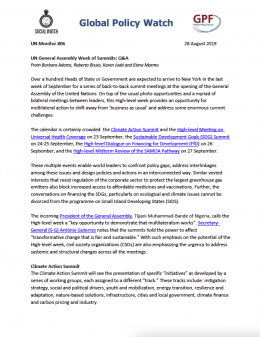By Barbara Adams, Roberto Bissio, Karen Judd and Elena Marmo
Over a hundred Heads of State or Government are expected to arrive to New York in the last week of September for a series of back-to-back summit meetings at the opening of the General Assembly of the United Nations. On top of the usual photo opportunities and a myriad of bilateral meetings between leaders, this High-level week provides an opportunity for multilateral action to shift away from ‘business as usual’ and address some enormous current challenges.
The calendar is certainly crowded: the Climate Action Summit and the High-level Meeting on Universal Health Coverage on 23 September, the Sustainable Development Goals (SDG) Summit on 24-25 September, the High-level Dialogue on Financing for Development (FfD) on 26 September, and the High-level Midterm Review of the SAMOA Pathway on 27 September.
These multiple events enable world leaders to confront policy gaps, address interlinkages among these issues and design policies and actions in an interconnected way. Similar vested interests that resist regulation of the corporate sector to protect the largest greenhouse gas emitters also block increased access to affordable medicines and vaccinations. Further, the conversations on financing the SDGs, particularly on ecological and climate issues cannot be divorced from the programme on Small Island Developing States (SIDS).
The incoming President of the General Assembly, Tijjani Muhammad-Bande of Nigeria, calls the High-level week a “key opportunity to demonstrate that multilateralism works”. Secretary-General (S-G) António Guterres notes that the summits hold the power to affect “transformative change that is fair and sustainable.” With such emphasis on the potential of the High-level week, civil society organizations (CSOs) are also emphasizing the urgency to address systemic and structural changes across all the meetings.

